Abstract
We have previously reported that mammalian tRNAsPhe from variation tissues contain different amounts of ribothymidine and that a uridine methylase from Escherichia coli can quantitatively convert these tRNAs to species that contain their full complement ofribothymidine at position 23 from the 3' terminus. The role of ribothymidine in mammalian tRNAs has now been investigated by studying the ability of several highly purified mammalian tRNAsPhe, differing only in their ribothymidine content, to support poly(U)-directed poly(Phe) synthesis under various conditions. Our results indicate that the ribothymidine content of mammalian tRNAPhe can be correlated with the ability of these tRNAs to functionin vitro in a low-magnesium (6 mM), ribosome wash factor-dependent, poly(U)-directed poly(Phe) synthesis system from rat liver. Specifically, the effect of increasing the ribothymidine content in a class C mammalian tRNA becomes manifest in an increased apparent maximum velocity for the overall synthesis of poly(Phe), while the apparent Michaelis constant (Km) remains essentially unchanged. It is postulated that the modifiednucleoside ribothymidine might be involved in the regulation of protein synthesis at the level of translation in mammalian liver.
Full text
PDF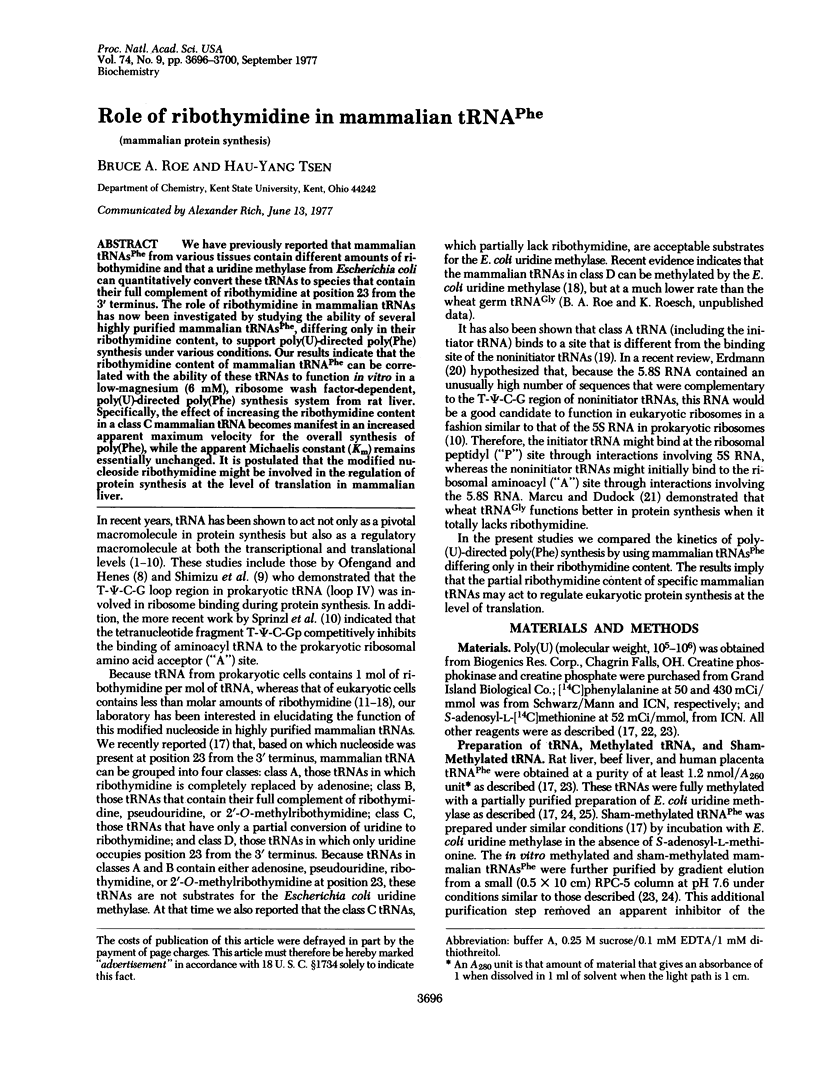
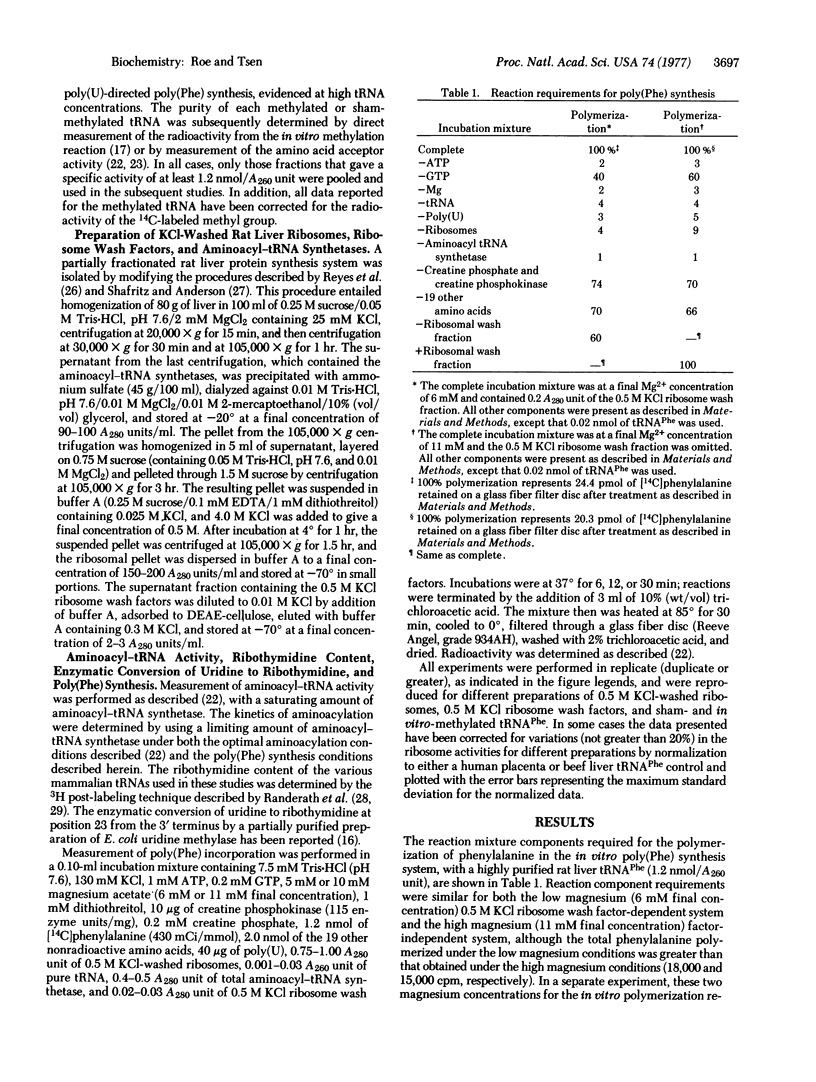
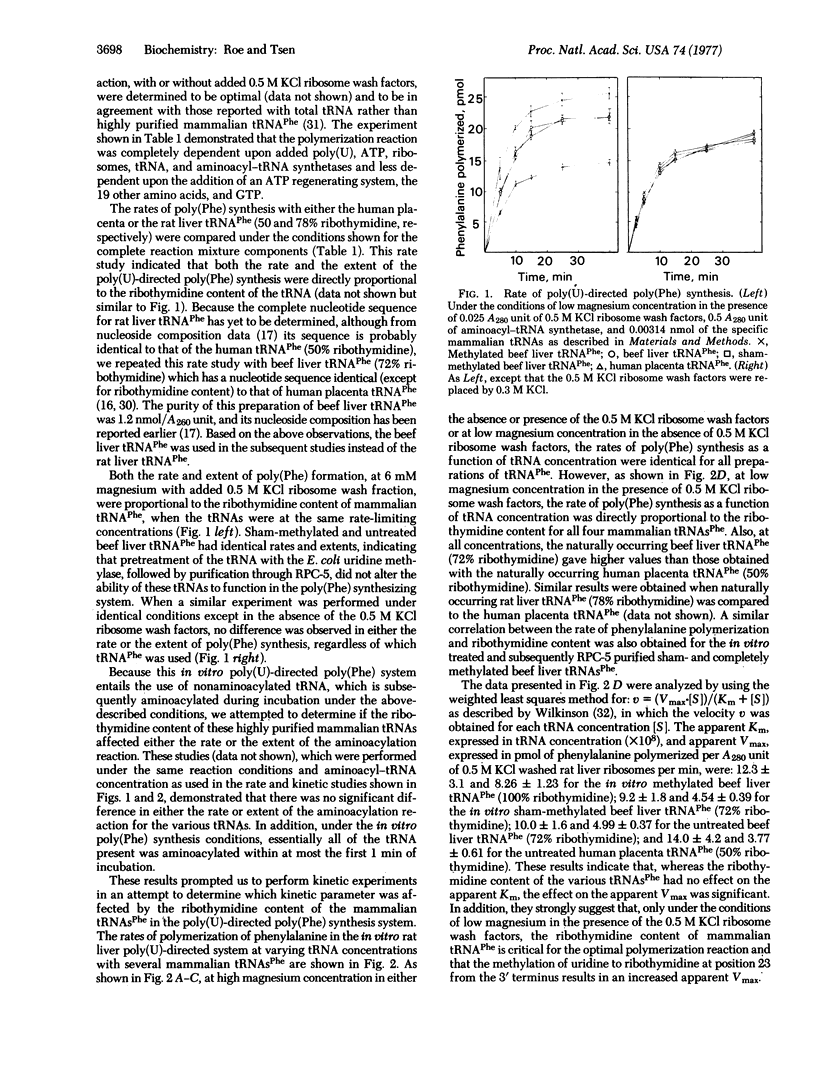
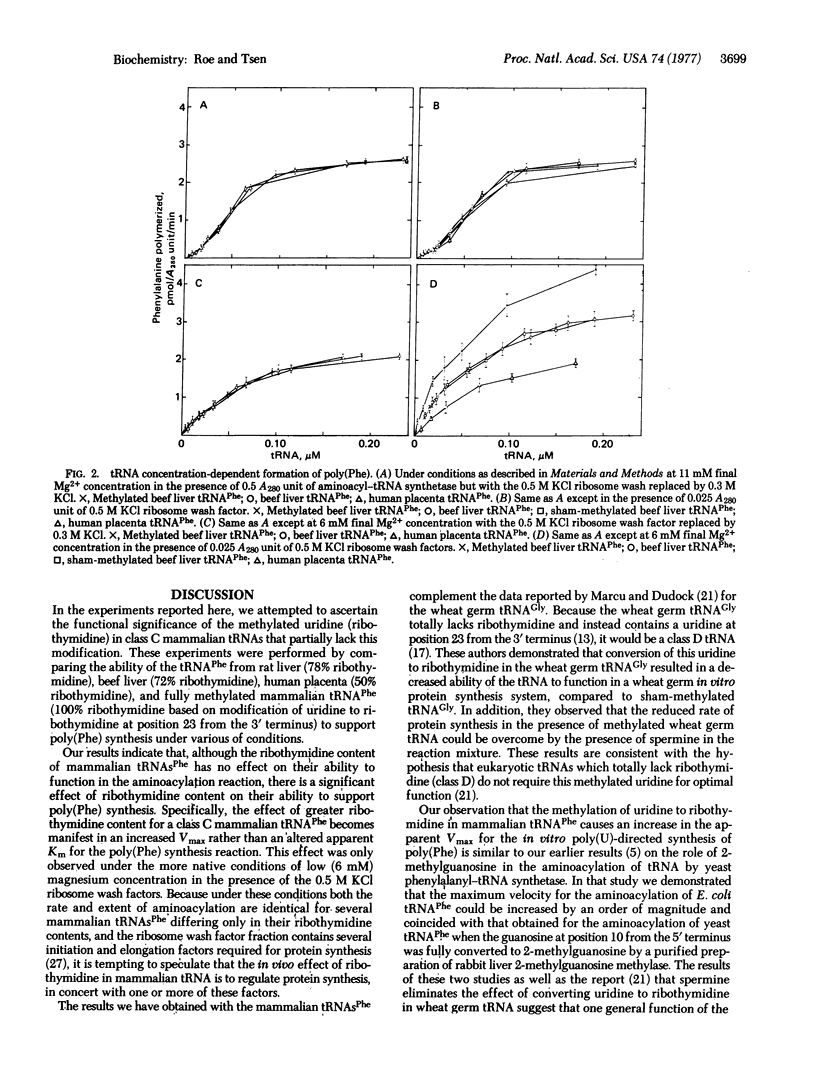
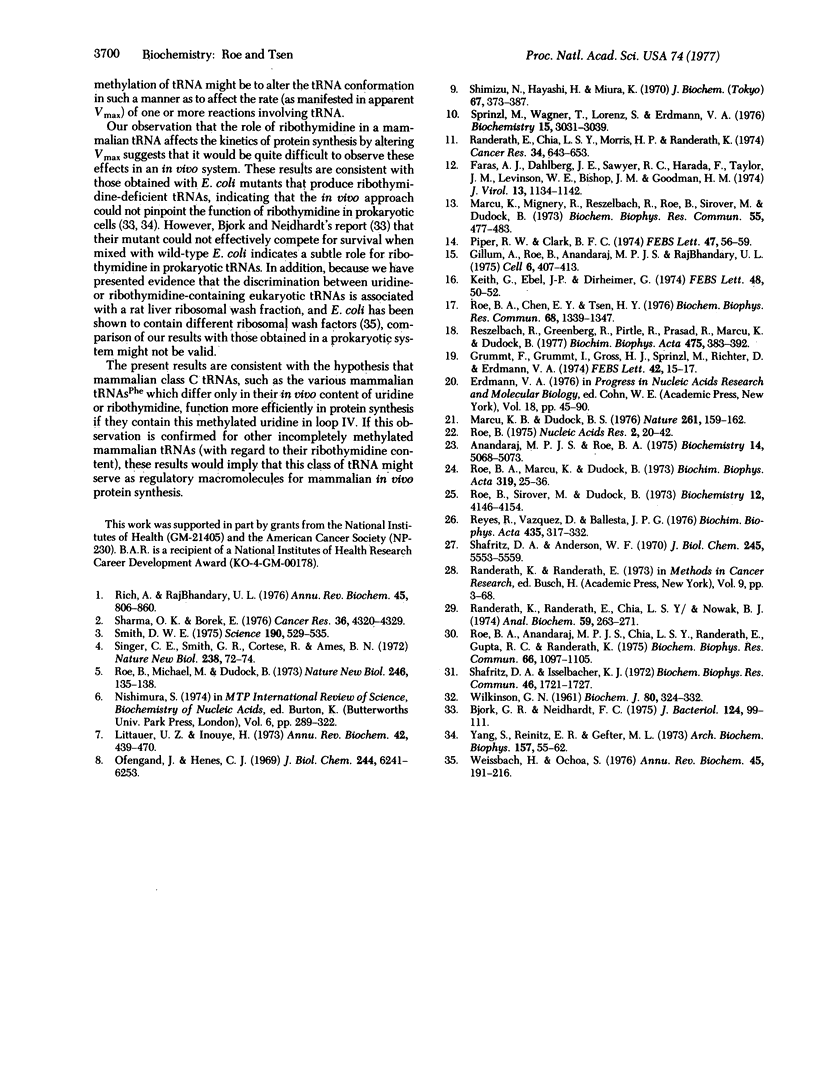
Selected References
These references are in PubMed. This may not be the complete list of references from this article.
- Amandaraj M. P., Roe B. A. Purification of human placenta phenylalanine, valine, methionine, glucine, and serine transfer ribonucleic acids. Biochemistry. 1975 Nov 18;14(23):5068–5073. doi: 10.1021/bi00694a006. [DOI] [PubMed] [Google Scholar]
- Björk G. R., Neidhardt F. C. Physiological and biochemical studies on the function of 5-methyluridine in the transfer ribonucleic acid of Escherichia coli. J Bacteriol. 1975 Oct;124(1):99–111. doi: 10.1128/jb.124.1.99-111.1975. [DOI] [PMC free article] [PubMed] [Google Scholar]
- Faras A. J., Dahlberg J. E., Sawyer R. C., Harada F., Taylor J. M., Levinson W. E., Bishop J. M., Goodman H. M. Transcription of DNA from the 70S RNA of Rous sarcoma virus. II. Structure of a 4S RNA primer. J Virol. 1974 May;13(5):1134–1142. doi: 10.1128/jvi.13.5.1134-1142.1974. [DOI] [PMC free article] [PubMed] [Google Scholar]
- Gillum A. M., Roe B. A., Anandaraj M. P., RajBhandary U. L. Nucleotide sequence of human placenta cytoplasmic initiator tRNA. Cell. 1975 Nov;6(3):407–413. doi: 10.1016/0092-8674(75)90190-7. [DOI] [PubMed] [Google Scholar]
- Grummt F., Grummt I., Gross H. J., Sprinzl M., Richter D., Erdmann V. A. Effects of T psi CG on the enzymatic binding of eukaryotic and prokaryotic initiator tRNAs to rat liver ribosomes. FEBS Lett. 1974 May 15;42(1):15–17. doi: 10.1016/0014-5793(74)80267-x. [DOI] [PubMed] [Google Scholar]
- Keith G., Ebel J. P., Dirheimer G. The primary structure of two mammalian tRNAs Phe: identity of calf liver and rabbit liver tRNAs Phe. FEBS Lett. 1974 Nov 1;48(1):50–52. doi: 10.1016/0014-5793(74)81059-8. [DOI] [PubMed] [Google Scholar]
- Littauer U. Z., Inouye H. Regulation of tRNA. Annu Rev Biochem. 1973;42:439–470. doi: 10.1146/annurev.bi.42.070173.002255. [DOI] [PubMed] [Google Scholar]
- Marcu K. B., Dudock B. S. Effect of ribothymidine in specific eukaryotic tRNAs on their efficiency in in vitro protein synthesis. Nature. 1976 May 13;261(5556):159–162. doi: 10.1038/261159a0. [DOI] [PubMed] [Google Scholar]
- Marcu K., Mignery R., Reszelbach R., Roe B., Sirover M., Dudock B. The absence of ribothymidine in specific eukaryotic transfer RNAs. I. Glycine and threonine tRNAs of wheat embryo. Biochem Biophys Res Commun. 1973 Nov 16;55(2):477–483. doi: 10.1016/0006-291x(73)91111-x. [DOI] [PubMed] [Google Scholar]
- Ofengand J., Henes C. The function of pseudouridylic acid in transfer ribonucleic acid. II. Inhibition of amino acyl transfer ribonucleic acid-ribosome complex formation by ribothymidylyl-pseudouridylyl-cytidylyl-guanosine 3'-phosphate. J Biol Chem. 1969 Nov 25;244(22):6241–6253. [PubMed] [Google Scholar]
- Piper P. W., Clark B. F. The nucleotide sequences of cytoplasmic methionine and valine tRNAs from mouse myeloma cells. FEBS Lett. 1974 Oct 1;47(1):56–59. doi: 10.1016/0014-5793(74)80425-4. [DOI] [PubMed] [Google Scholar]
- Randerath E., Chia L. L., Morris H. P., Randerath K. Transfer RNA base composition studies in Morris hepatomas and rat liver. Cancer Res. 1974 Mar;34(3):643–653. [PubMed] [Google Scholar]
- Randerath K., Randerath E., Chia L. S., Nowak B. J. Base analysis of ribopolynucleotides by chemical tritium labeling: an improved mapping procedure for nucleoside trialcohols. Anal Biochem. 1974 May;59(1):263–271. doi: 10.1016/0003-2697(74)90032-3. [DOI] [PubMed] [Google Scholar]
- Reszelbach R., Greenberg R., Pirtle R., Prasad R., Marcu K., Dudock B. Isolation and comparison of ribothymidine-lacking tRNAs of fetal, newborn and adult bovine tissues. Biochim Biophys Acta. 1977 Mar 18;475(2):383–392. doi: 10.1016/0005-2787(77)90027-2. [DOI] [PubMed] [Google Scholar]
- Reyes R., Vazquez D., Ballesta J. P. Activities of nucleoprotein particles derived from rat liver ribosome. Biochim Biophys Acta. 1976 Jul 16;435(4):317–332. doi: 10.1016/0005-2787(76)90198-2. [DOI] [PubMed] [Google Scholar]
- Rich A., RajBhandary U. L. Transfer RNA: molecular structure, sequence, and properties. Annu Rev Biochem. 1976;45:805–860. doi: 10.1146/annurev.bi.45.070176.004105. [DOI] [PubMed] [Google Scholar]
- Roe B. A., Anandaraj M. P., Chia L. S., Randerath E., Gupta R. C., Randerath K. Sequence studies on tRNAPhe from placenta: comparison with known sequences of tRNAPhe from other normal mammalian tissues. Biochem Biophys Res Commun. 1975 Oct 27;66(4):1097–1105. doi: 10.1016/0006-291x(75)90470-2. [DOI] [PubMed] [Google Scholar]
- Roe B. A., Chen E. Y., Tsen H. Y. Studies on the ribothymidine content of specific rat and human tRNAs: a postulated role for 5-methyl cytosine in the regulation of ribothymidine biosynthesis. Biochem Biophys Res Commun. 1976 Feb 23;68(4):1339–1347. doi: 10.1016/0006-291x(76)90343-0. [DOI] [PubMed] [Google Scholar]
- Roe B. A. Studies on human tRNA. I. The rapid, large scale isolation and partial fractionation of placenta and liver tRNA. Nucleic Acids Res. 1975 Jan;2(1):21–42. doi: 10.1093/nar/2.1.21. [DOI] [PMC free article] [PubMed] [Google Scholar]
- Roe B., Marcu K., Dudock B. The isolation and sequence analysis of transfer RNA: the use of plaskon chromatography (RPC-5). Biochim Biophys Acta. 1973 Aug 10;319(1):25–36. doi: 10.1016/0005-2787(73)90037-3. [DOI] [PubMed] [Google Scholar]
- Roe B., Michael M., Dudock B. Function of N2 methylguanine in phenylalanine transfer RNA. Nat New Biol. 1973 Dec 5;246(153):135–138. doi: 10.1038/newbio246135a0. [DOI] [PubMed] [Google Scholar]
- Roe B., Sirover M., Dudock B. Kinetics of homologous and heterologous aminoacylation with yeast phenylalanyl transfer ribonucleic acid synthetase. Biochemistry. 1973 Oct 9;12(21):4146–4154. doi: 10.1021/bi00745a018. [DOI] [PubMed] [Google Scholar]
- Shafritz D. A., Anderson W. F. Isolation and partial characterization of reticulocyte factors M1 and M2. J Biol Chem. 1970 Nov 10;245(21):5553–5559. [PubMed] [Google Scholar]
- Shafritz D. A., Isselbacher K. J. Liver protein synthesis: differences in the properties of membrane-bound and free ribosomes. Biochem Biophys Res Commun. 1972 Feb 25;46(4):1721–1727. doi: 10.1016/0006-291x(72)90808-x. [DOI] [PubMed] [Google Scholar]
- Sharma O. K., Borek E. A mechanism of estrogen action on gene expression at the level of translation. Cancer Res. 1976 Nov;36(11 Pt 2):4320–4329. [PubMed] [Google Scholar]
- Shimizu N., Hayashi H., Miura K. I. Functional sites of transfer RNA for the binding to messenger RNA-ribosome complex. J Biochem. 1970 Mar;67(3):373–387. doi: 10.1093/oxfordjournals.jbchem.a129261. [DOI] [PubMed] [Google Scholar]
- Singer C. E., Smith G. R., Cortese R., Ames B. N. [Mutant tRNA His ineffective in repression and lacking two pseudouridine modifications]. Nat New Biol. 1972 Jul 19;238(81):72–74. doi: 10.1038/newbio238072a0. [DOI] [PubMed] [Google Scholar]
- Smith D. W. Reticulocyte transfer RNA and hemoglobin synthesis. Science. 1975 Nov 7;190(4214):529–535. doi: 10.1126/science.1103288. [DOI] [PubMed] [Google Scholar]
- Sprinzl M., Wagner T., Lorenz S., Erdmann V. A. Regions of tRNA important for binding to the ribosomal A and P sites. Biochemistry. 1976 Jul 13;15(14):3031–3039. doi: 10.1021/bi00659a015. [DOI] [PubMed] [Google Scholar]
- WILKINSON G. N. Statistical estimations in enzyme kinetics. Biochem J. 1961 Aug;80:324–332. doi: 10.1042/bj0800324. [DOI] [PMC free article] [PubMed] [Google Scholar]
- Weissbach H., Ochoa S. Soluble factors required for eukaryotic protein synthesis. Annu Rev Biochem. 1976;45:191–216. doi: 10.1146/annurev.bi.45.070176.001203. [DOI] [PubMed] [Google Scholar]
- Yang S., Reinitz E. R., Gefter M. L. Role of modifications in tyrosine transfer RNA. II. Ribothymidylate-deficient tRNA. Arch Biochem Biophys. 1973 Jul;157(1):55–62. doi: 10.1016/0003-9861(73)90389-5. [DOI] [PubMed] [Google Scholar]


